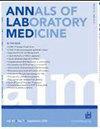Diagnostic Performance of Eight Blood-based Biomarkers in a Well-characterized Korean Cohort of Preclinical Alzheimer's Disease.
IF 3.9
2区 医学
Q1 MEDICAL LABORATORY TECHNOLOGY
引用次数: 0
Abstract
Background With the introduction of disease-modifying treatments for Alzheimer's disease (AD), less invasive and widely accessible screening tests are urgently needed. We assessed eight blood-based biomarkers in a well-defined cohort of preclinical AD, including participants with subjective cognitive decline (SCD) and mild cognitive impairment (MCI). Methods Amyloid beta (Aβ) oligomerization tendency, Aβ42, Aβ40, Aβ42/Aβ40 ratio, phosphorylated tau (p-tau)181, p-tau217, glial fibrillary acidic protein (GFAP), and neurofilament light (Nf-L) were assessed for distinguishing between SCD and MCI, for correlations, and for predicting Aβ positron emission tomography (PET) positivity. Results Plasma p-tau181, p-tau217, and GFAP levels were significantly higher in participants with MCI than in those with SCD (P <0.05) and in Aβ PET-positive versus Aβ PET-negative participants (P <0.0001), whereas plasma Aβ42 and Aβ42/40 ratio levels were significantly lower in Aβ PET-positive than in Aβ PET-negative participants (P <0.001). Logistic regression analysis revealed that plasma Aβ42 and p-tau217 levels predicted Aβ PET positivity with an area under the ROC curve (AUC) of 0.930 (95% confidence interval [CI], 0.848-0.976) in the entire cohort, and p-tau217 alone predicted Aβ PET-positivity with an AUC of 0.887 (95% CI, 0.779-0.954) in the MCI subgroup. Conclusions Plasma p-tau217 levels outperform plasma p-tau181 levels in predicting Aβ PET-positivity in participants with preclinical AD. Plasma GFAP levels, along with different p-tau isoforms (p-tau181 and p-tau217), effectively differentiate MCI from SCD. The predictive accuracy of blood-based biomarkers for Aβ PET-positivity strongly supports their clinical implementation, particularly with the introduction of disease-modifying therapies.8种基于血液的生物标志物在韩国临床前阿尔茨海默病队列中的诊断性能
随着阿尔茨海默病(AD)疾病修饰治疗的引入,迫切需要侵入性较小且可广泛获取的筛查试验。我们在一个明确定义的临床前AD队列中评估了8种基于血液的生物标志物,包括主观认知衰退(SCD)和轻度认知障碍(MCI)的参与者。方法评价β -淀粉样蛋白(Aβ)寡聚化倾向、β - 42、β - 40、β - 42/ β - 40比值、磷酸化tau蛋白(p-tau)181、p-tau217、胶质纤维酸性蛋白(GFAP)和神经丝光(Nf-L),用于区分SCD和MCI、相关性以及预测α - β正电子发射断层扫描(PET)阳性。结果MCI患者血浆P -tau181、P -tau217和GFAP水平显著高于SCD患者(P <0.05), Aβ pet阳性患者血浆a - β42和a - β42/40比值显著低于β pet阴性患者(P <0.001)。Logistic回归分析显示,血浆Aβ42和p-tau217水平预测整个队列中Aβ PET阳性的ROC曲线下面积(AUC)为0.930(95%可信区间[CI], 0.848 ~ 0.976),单独p-tau217预测MCI亚组中Aβ PET阳性的AUC为0.887 (95% CI, 0.779 ~ 0.954)。结论血浆p-tau217水平在预测临床前AD患者Aβ pet阳性方面优于血浆p-tau181水平。血浆GFAP水平以及不同的p-tau亚型(p-tau181和p-tau217)可有效区分MCI和SCD。基于血液的生物标志物对Aβ pet阳性的预测准确性有力地支持了它们的临床应用,特别是随着疾病改善疗法的引入。
本文章由计算机程序翻译,如有差异,请以英文原文为准。
求助全文
约1分钟内获得全文
求助全文
来源期刊

Annals of Laboratory Medicine
MEDICAL LABORATORY TECHNOLOGY-
CiteScore
8.30
自引率
12.20%
发文量
100
审稿时长
6-12 weeks
期刊介绍:
Annals of Laboratory Medicine is the official journal of Korean Society for Laboratory Medicine. The journal title has been recently changed from the Korean Journal of Laboratory Medicine (ISSN, 1598-6535) from the January issue of 2012. The JCR 2017 Impact factor of Ann Lab Med was 1.916.
 求助内容:
求助内容: 应助结果提醒方式:
应助结果提醒方式:


